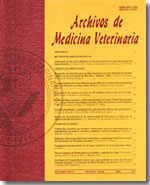Estudio comparativo de la próstata en perros mediante ecografía transrectal y transabdominal
Contenido principal del artículo
Resumen
Con el objetivo de evaluar las técnicas ecográficas transrectal y transabdominal para el examen de la glándula prostática en perros, se realizó un estudio en 20 perros machos enteros, clínicamente sanos, de 1,5 a 10 años de edad y un peso de 15 a 35 kg, los que fueron anestesiados con xilacina y ketamina E V. Se realizó la ecografía transrectal en un corte longitudinal con un transductor lineal de 7,5 MHz y la ecografía transabdominal con un transductor sectorial de 7,5 MHz. Los parámetros para comparar ambas técnicas fueron: a) posibilidad de observación de la glándula prostática, b) largo y alto máximo de la próstata, ecogenicidad y ecotextura prostática. La próstata se observó en todos los casos ecografiados con la técnica transrectal, a diferencia de la técnica transabdominal, en que se logró obtener cuatro imágenes completas, 11 incompletas, no observándose la glándula en cinco perros. Se encontraron diferencias significativas (P < 0,05) en las mediciones de largo y alto prostático al comparar ambas técnicas, siendo mayor el largo de la glándula prostática con la técnica transrectal y la altura con la técnica transabdominal. No se encontraron diferencias al comparar la ecogenicidad y ecotextura, sin embargo, el detalle de la imagen obtenida fue mejor con la técnica transrectal. Se concluye que la técnica ecográfica transrectal permitió visualizar completamente la próstata en todos los perros, a diferencia de la técnica transabdominal, en que no siempre se observó la glándula por encontrarse total o parcialmente dentro del canal pélvico. Se estima que ambos métodos de examen son complementarios e importantes de realizar en determinados casos.

